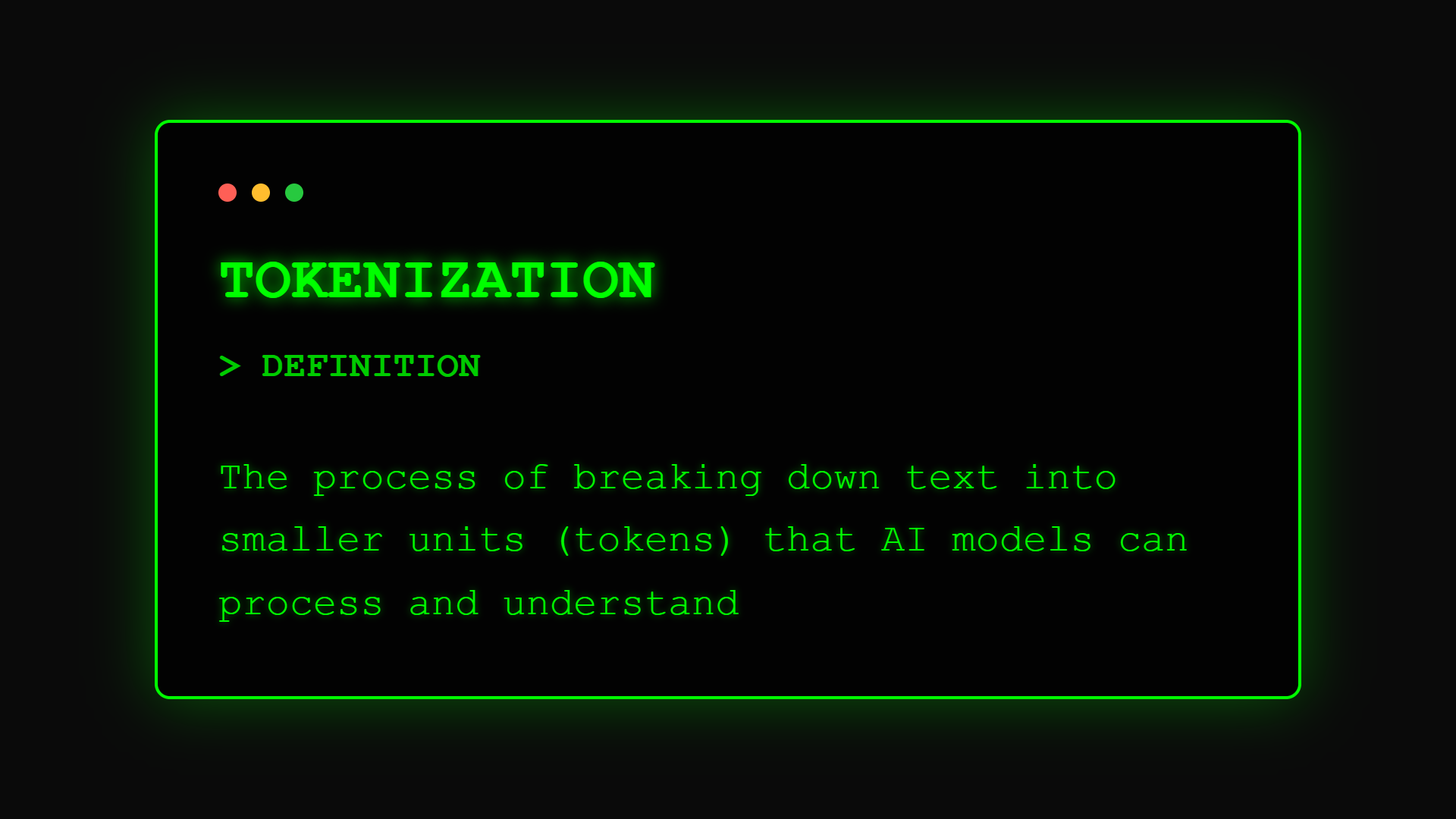AI Terms
What is Tokenization? Breaking Language into AI Building Blocks

Every word you type into ChatGPT gets chopped into pieces. That email your AI reads? Sliced and diced. This process – tokenization – is why AI can understand language and why your API bills depend on message length. Understanding it helps you optimize both AI performance and costs.
Technical Foundation
Tokenization is the process of breaking down text into smaller units called tokens, which serve as the fundamental units of meaning that AI language models can process. These tokens might be words, subwords, characters, or even pieces of words, depending on the tokenization strategy.
According to OpenAI's research, "Tokenization is a necessary preprocessing step that maps from raw text to sequences of integers that neural networks can process." Modern tokenizers use algorithms like Byte-Pair Encoding (BPE) or WordPiece to balance vocabulary size with coverage.
The innovation of subword tokenization solved the vocabulary explosion problem, allowing models to handle any word by breaking unknowns into known pieces.
Business Impact
For business leaders, tokenization directly affects your AI costs, performance, and capabilities – it determines how much you pay for API calls, how well AI understands specialized terminology, and whether it can handle multiple languages.
Think of tokenization like shipping packages. You can't send a whole warehouse at once – you break shipments into standard containers. Similarly, AI can't process entire documents at once; it needs text broken into standard pieces.
In practical terms, tokenization affects how many API calls your chatbot needs, whether AI understands your industry jargon, and how accurately it processes customer names or product codes.
How Tokenization Works
The tokenization process follows these steps:
• Text Normalization: Standardizing input text by handling cases, special characters, and formatting consistently
• Token Splitting: Breaking text into tokens using learned patterns – "unhappy" might become ["un", "happy"] or stay whole
• Vocabulary Mapping: Converting each token to a unique number (token ID) that the neural network processes
• Special Token Addition: Adding markers for sentence boundaries, padding, or special functions like [START] or [END]
• Sequence Creation: Arranging tokens into sequences that preserve meaning while fitting model constraints
Types of Tokenization
Different approaches for different needs:
Type 1: Word Tokenization Unit: Complete words Example: "AI improves efficiency" → ["AI", "improves", "efficiency"] Best for: Simple analysis, traditional NLP
Type 2: Subword Tokenization Unit: Word pieces Example: "unbelievable" → ["un", "believ", "able"] Best for: Modern language models, handling rare words
Type 3: Character Tokenization Unit: Individual characters Example: "AI" → ["A", "I"] Best for: Typo-resistant applications, code processing
Type 4: Byte-Pair Encoding (BPE) Unit: Learned frequent sequences Example: Complex, learned from data Best for: GPT models, multilingual processing
Tokenization in Practice
Real impacts on business applications:
Cost Example: OpenAI charges per token. "Hello world" = 2 tokens ($0.0004), but "Antidisestablishmentarianism" = 7 tokens ($0.0014). Customer service responses averaging 500 tokens cost $0.10 each, so token-efficient prompts save money.
Performance Example: Medical AI tokenizing "acetaminophen" as ["acet", "amino", "phen"] can understand related terms like "acetylsalicylic" better than word-level tokenization, improving diagnosis accuracy.
Multilingual Example: Google's mBERT uses wordpiece tokenization to handle 104 languages in one model, enabling global customer support without separate models per language.
Token Limits and Context Windows
Understanding constraints:
• Context Windows: Models have maximum token limits (GPT-4: 128k tokens, Claude: 100k tokens) affecting how much information you can process at once
• Token Budgeting: Must balance prompt instructions, context, and response space within limits
• Chunking Strategies: Long documents need intelligent splitting to maintain coherence across chunks
• Cost Optimization: Fewer tokens = lower costs, but oversimplification hurts quality
Business Considerations
Key factors for implementation:
Industry Terminology:
- Custom tokenizers for specialized vocabulary
- Fine-tuning to recognize domain terms
- Glossary integration for consistency
Data Privacy:
- Tokenization can expose or hide sensitive data
- Consider where tokenization happens
- Audit token vocabularies for leakage
Performance Optimization:
- Token-efficient prompt engineering
- Caching common token sequences
- Batching strategies for throughput
Common Tokenization Challenges
Issues and solutions:
• New Terms: AI struggles with brand names or new products → Solution: Fine-tuning or prompt engineering with definitions
• Numbers and Codes: Product SKUs tokenize poorly → Solution: Preprocessing or special handling for structured data
• Languages Mixing: Code-switching confuses tokenizers → Solution: Multilingual models or language detection
• Token Waste: Formatting consuming valuable tokens → Solution: Preprocessing and efficient prompt design
Optimizing for Tokenization
Best practices for efficiency:
- Understand your model's tokenizer using online tools
- Design prompts considering token boundaries
- Preprocess data to reduce token usage
- Monitor token consumption in production
- Consider custom tokenization for specialized domains
Connecting the Dots
Ready to optimize your AI language processing?
- See how tokens become Embeddings
- Understand Large Language Models using tokens
- Master Prompt Engineering with token awareness
- Read our Token Optimization Guide
FAQ Section
Frequently Asked Questions about Tokenization
Part of the [AI Terms Collection]. Last updated: 2025-01-11